|
|
|
Sort Order |
|
|
|
Items / Page
|
|
|
|
|
|
|
| Srl | Item |
| 1 |
ID:
112620
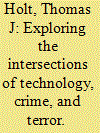

|
|
|
|
|
| Publication |
2012.
|
| Summary/Abstract |
The Internet and computer-mediated communications (CMCs) have drastically changed the way that individuals communicate and share information across the globe. Over the last two decades, financial institutions, private industry, and governments have come to rely on technology in order to access sensitive data and manage critical infrastructure, such as electrical power grids. As a consequence, the threat posed by cybercriminals has increased dramatically and afforded significant opportunities for terrorist groups and extremist organizations to further their objectives. The complex and intersecting nature of both crime and terror make it difficult to clearly separate these issues, particularly in virtual environments, due to the anonymous nature of CMCs and challenges to actor attribution. Thus, this study examines the various definitions for physical and cyberterror and the ways that these activities intersect with cybercrime. In addition, the ways that terrorists and extremist groups use the Internet and CMCs to recruit individuals, spread misinformation, and gather intelligence on various targets are discussed. Finally, the uses of computer hacking tools and malware are explored as a way to better understand the relationship between cybercrime and terror.
|
|
|
|
|
|
|
|
|
|
|
|
|
|
|
|
| 2 |
ID:
112619
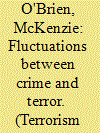

|
|
|
|
|
| Publication |
2012.
|
| Summary/Abstract |
The Abu Sayyaf Group (ASG) in the Philippines is often labeled a terrorist organization, yet there are periods when the group has engaged in far more criminal activity than terrorism. Specifically, this article describes phases in which organized criminal activity far exceeds any terrorist activities before returning to a more predominant focus on terrorism. This study explores reasons for these temporal fluctuations in criminal versus terrorist activity from 1991 thru August 2011, identifying four categories of explanatory factors: leadership, structure, membership and grievances, and linkages to other actors. The study concludes by highlighting some implications for policy, research, and the future of ASG.
|
|
|
|
|
|
|
|
|
|
|
|
|
|
|
|
| 3 |
ID:
112614
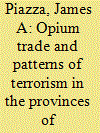

|
|
|
|
|
| Publication |
2012.
|
| Summary/Abstract |
Contemporary terrorist movements in Afghanistan are frequently alleged to be fueled, in part, by the country's voluminous opium trade. Experts argue that terrorist groups currently active in Afghanistan, like the Afghan Taliban, the Islamic Movement of Uzbekistan, Hizbul Islami, and various al-Qaeda affiliates, use drug trade profits to recruit and pay cadres, acquire weapons and equipment, and bribe officials while becoming more powerful, and deadly, in the process. This study empirically examines the relationship between the opium trade and terrorism in Afghanistan by conducting a series of negative binomial regression estimations on terrorist attacks and casualties in the 34 Afghan provinces for the period 1996 to 2008. The analysis also considers various economic development, infrastructure, geographic, security, and cultural factors when examining causes of terrorism in the provinces. The study determines that, across all model specifications, provinces that produce more opium feature higher levels of terrorist attacks and casualties due to terrorism, and that opium production is a more robust predictor of terrorism than nearly all other province features. Furthermore, tests indicate that the direction of causation runs from opium production to higher rates of terrorism, not otherwise. The study concludes with a brief discussion of the policy implications of the findings.
|
|
|
|
|
|
|
|
|
|
|
|
|
|
|
|
| 4 |
ID:
112612


|
|
|
|
|
| Publication |
2012.
|
| Summary/Abstract |
Nation-states and security planners continue to place a high emphasis on threat convergence, such as that which emanates from the links between transnational organized crime and international terrorism. The social and behavioral sciences are not silent on this topic. This article frames the existing literature on crime-terror interaction to demonstrate that threat convergence is more complex than policymakers and practitioners often realize. With terror and crime groups evolving to resemble one another, convergence is undermining the conventional wisdom that limited crime-terror interaction to short-term relationships due to divergent motives. The contemporary threat environment is promoting longer-term cooperation between organized crime and terrorism, in some cases resulting in hybrid organizations that merge elements of both. This article concludes by giving suggestions for future multidisciplinary research in this field as well as supporting the formation of new strategies to combat threat convergence.
|
|
|
|
|
|
|
|
|
|
|
|
|
|
|
|
| 5 |
ID:
112615
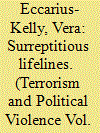

|
|
|
|
|
| Publication |
2012.
|
| Summary/Abstract |
The Armed Revolutionary Forces of Columbia (FARC) and Kurdistan Workers Party (PKK) have both demonstrated an uncanny ability to transform themselves and adapt to changing environmental conditions. Integral to the groups are webbed criminal enterprises, cross-border sanctuaries, and internationally-oriented advocacy networks. Both organizations avoided catastrophic breakdowns through a combination of organic survival mechanisms and precise organizational restructuring. Since 2008, the FARC moved away from a centralized wheel structure model toward a system of multiple decision-making nodes. Guerrilla units now operate in an atomized manner since they are often disconnected from the central leadership. This encouraged a growing number of FARC commanders to focus on narco-profits rather than the organization's ideological goals. Meanwhile, the PKK functions in an octopus-like manner, extending its tentacles into neighboring countries and Europe. However, the process of democratization in Turkey and improved international law enforcement collaboration increased internal as well as external pressure on the PKK to restructure. As a result the PKK is struggling to keep its far-reaching tentacles coordinated. The PKK misjudged its ability to manage political groups which weakened its ideological grip, yet the organization's control over criminal and guerrilla branches continues to be as fierce as ever. The FARC's and the PKK's organizational changes suggest that security agencies in Colombia and Turkey need to adapt their counterterrorism strategies also.
|
|
|
|
|
|
|
|
|
|
|
|
|
|
|
|
| 6 |
ID:
112616
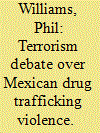

|
|
|
|
|
| Publication |
2012.
|
| Summary/Abstract |
Violence in Mexico related to drug trafficking has expanded enormously, and observers have begun using terms like terrorism, nacro-terrorism, and criminal insurgency to label the violence. However, arguments that Mexico is the victim of growing terrorism are both exaggerated and unconvincing. While there have been many murders of innocent civilians, these killings do not seem to have been motivated by a political, ideological, or religious cause. This analysis seeks to understand the nature of the expanding violence in Mexico. It starts from the premise that the violence is a complex and multi-layered phenomenon with a variety of different rationales and motivations. From this perspective, a pyramidal approach to the violence can be identified. At the base of the pyramid is the notion of drug-related violence as the medium of rational strategic competition in a highly lucrative illicit market. A second layer in the pyramid emphasizes factionalism within the organizations as well as a process of contracting out for much of the violence to youth gangs and specialists. And a third perspective on the violence puts less emphasis on organizations and more on the degeneration of norms and inhibitions.
|
|
|
|
|
|
|
|
|
|
|
|
|
|
|
|
| 7 |
ID:
112618


|
|
|
|
|
| Publication |
2012.
|
| Summary/Abstract |
Despite concerns about the growing threat posed by domestic radical environmental and animal rights groups to the United States, there has been little systematic quantitative evidence depicting the characteristics of their attacks over time. In this paper we analyze data on 1,069 criminal incidents perpetrated by environmental and animal rights extremists from 1970 to 2007. Based on the Global Terrorism Database's definition of terrorism, we classified 17 percent of these incidents as terrorist. To supplement the analysis, we also conducted interviews with a nonrandom sample of twenty-five activists who self-identified as part of the environmental or animal rights movements. We find that overall, the attacks staged by radical environmental and animal rights groups thus far have been overwhelmingly aimed at causing property damage rather than injuring or killing humans. Further, results from our interviews suggest that activists appear to weigh carefully the costs and benefits of illegal protest. Despite the fact that attacks by environmental and animal rights groups have thus far been almost universally nonviolent, concerns linger that this situation might change in the future.
|
|
|
|
|
|
|
|
|
|
|
|
|
|
|
|
| 8 |
ID:
112617


|
|
|
|
|
| Publication |
2012.
|
| Summary/Abstract |
Drawing from interviews, surveys, and other forms of research conducted in Lebanon, Gaza and the West Bank, and Mexico, this article compares Mexican cartels to Hamas and Hezbollah. The similarities between them are striking: these are all by necessity territorially specific organizations tied to relatively defined geographic locations, and have deep and sophisticated relationships with the states within which they operate. However, there are critical differences between Mexican drug cartels and Hamas and Hezbollah as well, the most important (according to an analysis of multiple definitions of terrorism) being the presence of political and ideological motivations. This analysis illustrates the conceptual challenges and classificational ambiguity involved in analyzing terrorism and organized crime.
|
|
|
|
|
|
|
|
|
|
|
|
|
|
|
|
| 9 |
ID:
112613


|
|
|
|
|
| Publication |
2012.
|
| Summary/Abstract |
Political organizations claim they are serving the interests of their constituents-but being involved in the drug trade does not seem to support those claims. Why would political organizations sell drugs then? Most often the question of why organizations engage in the drug trade has been explored in the context of organizations that are either criminal or violent, thus leaving a large hole in the literature about how violence and legality intersect with other exploratory factors. We explore this issue more fully by looking at both violent and nonviolent organizations using the Middle East Minorities at Risk Organizational Behavior dataset, which has data on over 100 ethnopolitical organizations in the Middle East. Very few of these organizations are involved in the drug trade and yet all of those are engaged in violence at the same time. We explore what factors, other than violence, make this rare behavior for political organizations more likely.
|
|
|
|
|
|
|
|
|
|
|
|
|
|
|
|
|
|
|
|
|